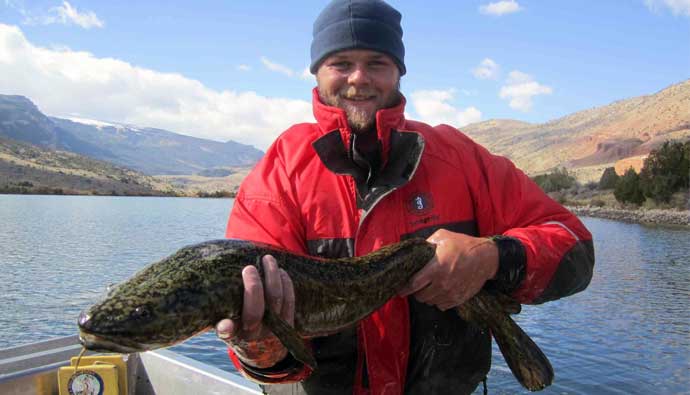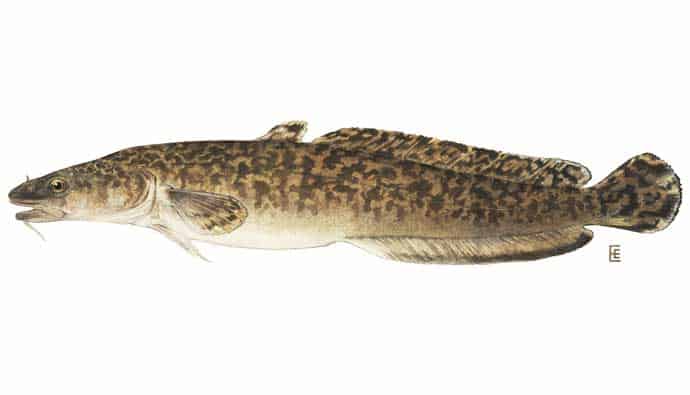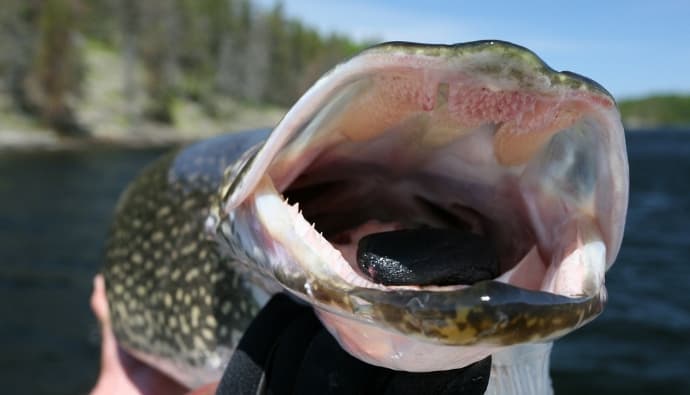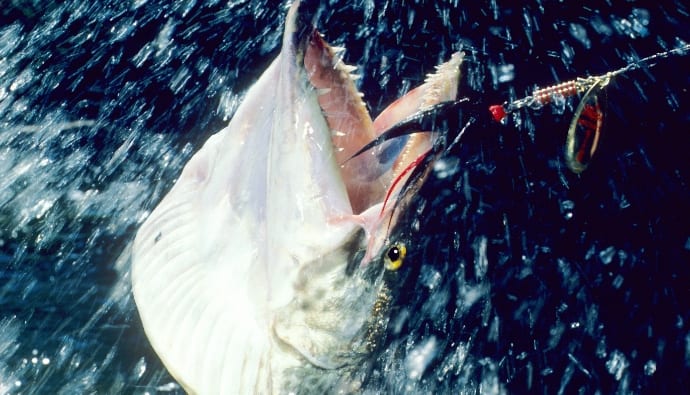Burbot is an interesting fish to target because they live under the ice and are a fierce predator.
It’s not uncommon for them to attack fish the same size as them. They also target the eggs of species like sockeye salmon, so they are known to wreak havoc on other fish populations like brown and lake trout.

For example, in Utah, the Utah Division of Fish and Game has a no-release, catch-and-kill policy for burbot.
We hope you find this guide helpful to catch a few this ice-fishing season.
Recommended Burbot Ice Fishing Gear:
- Rod: Berkley Cherrywood HD
- Reel: Abu Garcia Pro Max Low Profile
- Tackle: VMC Crankbait Snap + Spoon + Bait on Treble
Overview
The burbot is not the most attractive fish and does not fight as hard, but they are still popular sport fish. This unusual-looking fish has mottled skin that ranges from black to olive and yellow in color.

The dorsal and anal fins are elongated and extend all the way to a rounded caudal fin which is why it is often confused with the eelpout fish. It also has a soft barb on its lower jaw.
Also known as lingcod, methy, lawyer, and mud shark. The fish can be found throughout North America, Asia, and Europe in large clear and glacial rivers and lakes. Young burbots survive on zooplankton and insects, while adults prefer fish.
Burbot Facts
| Scientific Name | Lota lota |
| Common Name(s) | Burbot, bubbot, mariah, freshwater ling, the lawyer, coney-fish, lingcod, freshwater cusk, and eelpout |
| Family | Lotidae |
| Identifying Characteristics | It has mottle skin that ranges from black to olive and yellow in color. The dorsal and anal fins are elongated and extend all the way to a rounded caudal fin which gives it an eel-like appearance. It also has a soft barb on its lower jaw. |
| Depth Range | 300 m |
| Habitat | Can be found in the Pacific, Mediterranean, and Western Atlantic oceans. |
| Limits | Check your local regulations |
| Largest Recorded | 25+ pounds |
Where to Catch
Burbot prefers to remain in large and cold lakes, reservoirs, and rivers. Yet it prefers freshwater habitats and thrives in brackish environments. This is especially true when it is spawning.
In summer, the burbot can be found in colder water under the thermocline. It can tolerate a range of substrates from the rubble to gravel for feeding.
Burbot can be found in parts of Canada and colder regions of the United States and Europe.
How to Catch Burbot

There are three main methods that are popular for catching burbot. One is called still-fishing, which employs heavy sinkers and dead or alive stink bait. The second is active, which employs several types of heavy lures. The third is, of course, ice fishing since burbot is primarily a winter target.
If you are going for live bait, use eels, crayfish, whitefish, nightcrawlers, leeches, snails, or freshwater mussels. You can also use any benthic fish that dwell in the lake with the burbot, but it is not very picky. For dead bait, use strips of salmon, sucker, carp, or liver. Use glow-in-the-dark burbot lures, spoons, and spinners if you are going after them at night.
You can get away with an 8 lb braid. Just make sure you put a monofilament or fluorocarbon fishing leader for a shock absorber. Generally, your walleye fishing setup will work for burbot too.
Fishing Tactics
- If you are still fishing for burbot and not handling the rod too much, use a slow action rod, and if you are jigging, use a shorter rod.
- If you are ice fishing, fish right next to rocky areas within bays or the mouth of bays that are tucked within a large cliff.
Fishing Tips
- Keep your burbot fishing rigs within a few inches off the bottom in 20 to 60 feet to get a productive catch.
- Get a second or third fish quickly by sending the lure back down as soon as you release the first burbot in the boat.
Seasons
As the temperature drops, the burbot becomes more active and can be caught in droves. The best time to catch a burbot is in the winter months, i.e., in December, January, and February.
The freshwater ling spawns in the middle of winter during severe frost, a period which can last over 2 weeks. During this time, the burbot doesn’t feed, so you should angle for it when it begins to fatten after spawning.
How to Clean
- Place the burbot in a clean work area and use a sharp knife to make a shallow cut in the skin, around the base of the head, and behind the pectoral fins and gill plate.
- Grab the edges of the skin that lies with the cut with pliers and gently pull it off toward the tail. Work the skin around the cut to ensure the skin removes evenly, and you don’t get any meat or tear the skin.
- Keep pulling till the skin comes off in one piece off the end of the tail or caudal fin.
- Lay the skinned burbot on its belly and grasp the dorsal fin as close to the base as possible and start pulling up toward the tail till the entire fin is off. Flip and repeat the process with the anal fin.
- Insert the knife into the crevice made by the removed dorsal fin and slice alongside the spine till you hit the rib bones. Run the knife on top of the bones toward the tail.
- Inset the knife through the tail meat from the back to the belly and then cut toward the tail.
- Run the knife alongside and along the ribs till you free the fillet. Repeat on the other side for the second fillet and remove the tender belly meat as well.
How to Cook Burbot
Burbot eating ranks high for those anglers who catch them. Similar to fishermen who do a lot of ling fishing, this freshwater ling is great table fare.
Let’s see how to turn this delicious wildlife into a meal.
Burbot Recipe
- Sprinkle salt and pepper on the burbot fillets.
- Roll them in flour or cornmeal or a mix of both.
- Place the burbot fillets skin-side down in a heated heavy iron skillet with 2 tablespoons of shortening.
- Flip when the fish turns golden brown on one side and cook till it is done.
- Serve the burbot with lemon wedges.
Frequently Asked Questions
Q: Are burbot good to eat?
A: Yes, the firm and white flesh of burbot taste like haddock and cod and is excellent when it is served fried or broiled.
Q: How big do burbot get?
A: On average, an adult burbot can grow up to 40 to 120 cm. The biggest was over 25 pounds caught in Canada.
Q: Are burbot bottom feeders?
A: Burbot are piscivores and they prey on lamprey, grayling, whitefish, trout, stickleback, and even perch.
Insider Advice
The best time to fish for burbot is during the night in the middle of winter if you can brave the severe weather and the dark. Make sure that you have others with you in case you fall into the deep and freezing water.
This freshwater fish is known for coiling around arms that are trying to unhook it. Since it can be quite heavy, you may find yourself in the water with it.




 Facebook
Facebook YouTube
YouTube








